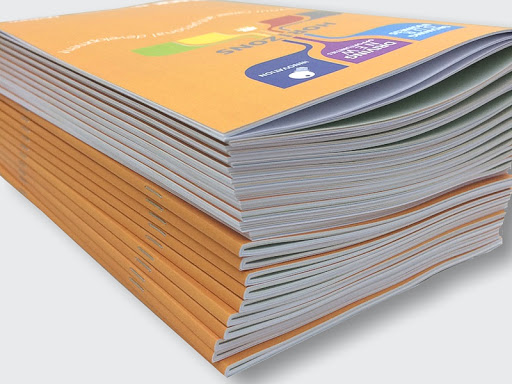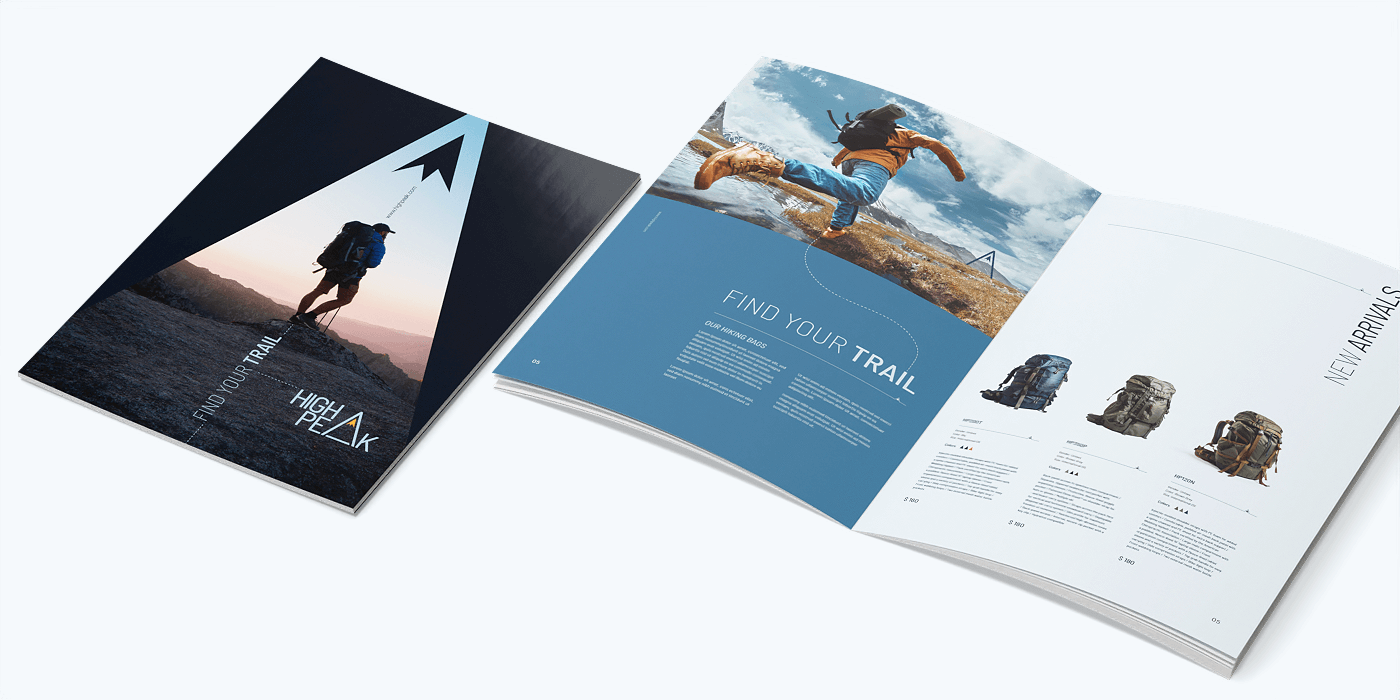How to Use Booklet Printing to Boost Customer Engagement in 2025
Wiki Article
The Crucial Overview to Comprehending Brochure Printing Options and Techniques
The process of booklet printing entails numerous considerations that can significantly impact the last item. From choosing the appropriate layout and dimension to comprehending the nuances of binding approaches, each option plays a vital function. Additionally, variables such as paper stock and printing techniques more influence the effectiveness of the pamphlet. As one navigates these options, it comes to be necessary to comprehend how they adjoin and what that implies for the total result.Understanding Pamphlet Styles and Sizes
When taking into consideration booklet printing, recognizing the different layouts and sizes readily available is necessary for achieving the wanted discussion. Pamphlets can be produced in various styles, consisting of saddle-stitched, spiral-bound, and perfect-bound, each offering distinctive benefits. Common sizes range from conventional letter (8.5 x 11 inches) to smaller sized choices like A5 (5.8 x 8.3 inches), enabling flexibility based upon content and target audience.Selecting the suitable dimension can influence both the design and viewers engagement. Larger dimensions might fit aesthetically driven web content, while smaller styles might be more user-friendly and portable. Furthermore, the variety of web pages affects the option of binding technique, as thicker pamphlets may require stronger bindings. Inevitably, recognizing these aspects permits a much more customized strategy, ensuring that the end product lines up with the desired message and visual, enhancing the overall effectiveness of the communication.Selecting the Right Paper Supply

Binding Methods: Choices and Factors To Consider
When it pertains to binding approaches for booklets, several choices are readily available, each with distinct advantages. Saddle stitch binding provides a cost-efficient solution for thinner booklets, while ideal binding methods give an even more polished search for thicker publications. Wire-O binding stands apart for its longevity and convenience of use, making it optimal for documents that require versatility.Saddle Stitch Binding
Saddle stitch binding supplies a practical and cost-effective service for assembling brochures, making it a popular selection amongst publishers and services. This binding method entails folding sheets of paper in fifty percent and stapling them along the fold line, producing a orderly and neat appearance. Generally suitable for booklets with a reduced web page count, saddle stitching is perfect for magazines, sales brochures, and educational products. The simplicity of this technique permits fast manufacturing and is typically favored for marketing items or brief runs. Nevertheless, it is important to note that saddle stitch binding might not be ideal for thicker brochures, as the spine might not hold up under increased weight. In general, it stays a reliable option for lots of printing tasks.Perfect Binding Strategies
Perfect binding is a widely used method that supplies a sleek and specialist surface to booklets and publications. This approach includes gluing the web pages together at the back using a solid adhesive, permitting a tidy side and the capability to hold a bigger number of pages contrasted to saddle stitching. Perfect binding is especially appropriate for thicker booklets, such as directories and yearly reports, where a tough, flat spinal column is wanted. Additionally, it uses the option for a printed cover that can be made to enhance visual appeal. Factors to consider such as page count, paper weight, and the intended usage of the brochure need to be taken into account, as they can impact toughness and total quality.Wire-O Binding Options
Wire-O binding, understood for its toughness and adaptability, offers an outstanding choice for brochures that call for very easy web page transforming and a specialist look. This binding method employs a series of metal loops that hold pages securely, allowing them to exist level when open. It is specifically ideal for guidebooks, directories, and discussions as a result of its durable nature. Wire-O binding is available in various colors and sizes, accommodating various page counts and densities. Furthermore, it permits the inclusion of tabs and covers, improving the brochure's overall visual. Factors to consider for Wire-O binding consist of the option of cable shade, the size of the loops, and the level of modification preferred, all of which can profoundly affect the last product's appearance and capability.Digital vs. Offset Printing: Which Is Best for You?
When picking a printing approach for brochures, understanding the distinctions between electronic and balance out printing is vital. Digital printing utilizes modern-day technology to produce high-grade prints swiftly and affordably, making it ideal for brief runs or projects calling for quick turn-around times. It permits modification, supplying the ability to publish on-demand with minimal waste.In contrast, counter printing is a standard method that succeeds in producing big quantities with constant top quality. It includes moving ink from a plate to a rubber blanket, after that to the paper, which causes precise details and vivid colors. Nevertheless, offset printing usually calls for longer setup times and is a lot more cost-effective for larger volumes.Ultimately, the option in between digital and balance out printing relies on project demands, spending plan, and wanted quantity. For tiny, time-sensitive tasks, electronic could be the finest option, while balanced out might be more suitable for bigger, top quality manufacturings.
Creating Your Booklet: Tips and Best Practices
When creating a pamphlet, cautious attention to layout, font style choice, and shade usage can considerably boost its effectiveness. A well-structured format guides the visitor's eye, while ideal typefaces assure readability and communicate the preferred tone. Additionally, reliable use color can stimulate emotions and highlight vital information, making the overall layout more impactful.Picking the Right Design
How can one effectively pick the ideal design for a booklet? Initially, it is necessary to examine the booklet's objective and target market. A clean, arranged design improves readability and engagement. Using a grid system can aid in lining up elements constantly, producing a professional look. Additionally, integrating visual pecking order with varying dimensions and positionings of pictures and message can guide the visitor's eye and emphasize vital information. It is additionally vital to leave adequate white room, which avoids congestion and enables much better emphasis. Finally, checking various layouts through mock-ups can provide insight right into how the style does in real-world situations, making sure that the end product fulfills both visual and practical requirements.Choosing Proper Font Styles
An appropriate font can significantly improve the general style of a brochure, matching the design and enhancing the web content's message. The option of typefaces need to consider readability, particularly for body message, as it assures the info comes to all viewers. Sans-serif typefaces are usually preferred for digital layouts, while serif typefaces can offer a standard feeling in printed products. It's a good idea to limit font choices to 2 or 3 to preserve visual coherence. Additionally, font dimension plays a vital This Site function; headings ought to be unique however not overwhelming, while body text need to be comfy for analysis. When choosing fonts, placement with the brochure's theme and target market is crucial for reliable communication and aesthetic allure.Efficient Usage of Color
Shade works as an effective tool in pamphlet style, leading and shaping understandings reader emotions. It can stimulate feelings of calmness, depend on, or exhilaration, depending on the shades picked. Developers ought to take into consideration color concept principles, making sure that the chosen palette lines up with the pamphlet's message and target audience. For instance, using cozy shades like red and orange can develop urgency, while cooler tones like blue and environment-friendly foster tranquility.Additionally, contrast plays a crucial duty; corresponding colors can boost readability and visual appeal. Consistency in color usage across pages further reinforces brand name identification and communication. Inevitably, reliable shade execution not only captures attention but also reinforces the booklet's purpose, making it a vital element of effective style.
Completing Touches: Coatings and Special Effects
While many think about the content and layout of a booklet one of the most essential components, the finishing touches, such as coverings and special effects, play an essential duty in boosting its general appeal. Coatings can supply security and toughness, making sure that the brochure withstands wear and tear. Matte coatings provide a sophisticated, non-reflective surface area, while shiny finishings can make colors show up more distinctive and lively. Special impacts, like embossing or aluminum foil stamping, include a tactile dimension that can produce a memorable impact. These methods can highlight specific locations, accentuating essential information or producing visual rate of interest. Additionally, UV layer can supply a high-shine finish that raises the overall look.Together, these completing touches not just improve the pamphlet's aesthetic yet also connect professionalism and reliability and focus to detail, inevitably leaving a long lasting influence on the reader.Expense Factors To Consider for Booklet Printing
Comprehending the numerous cost factors to consider for booklet printing is vital for companies and businesses aiming to enhance their spending plans. Key elements affecting prices include the option of ink, paper, and binding approaches. Better materials, such as superior paper or specialized inks, commonly increase the overall cost. Furthermore, the dimension and web page matter of the pamphlet play a significant role; larger brochures need even more sources and time to produce.Another vital factor to consider is the printing technique, whether digital or offset, as each has its own pricing structure and suitability for different quantities. Companies ought to likewise factor in style expenses, which can vary based on complexity and the use of professional solutions. Inevitably, shipping and handling charges can include in the overall, specifically for huge orders. By reviewing these components, companies can make educated choices that line up with their financial capabilities while achieving the desired quality in their printed materials.Frequently Asked Inquiries
What Are the Ecological Effects of Brochure Printing?
The environmental impacts of pamphlet printing consist of deforestation from paper production, carbon emissions from transport, and waste generation from disposed of materials - Booklet Printing. Sustainable techniques, such as utilizing recycled paper and environment-friendly inks, can reduce these effectsHow Can I Make Certain Shade Accuracy in My Pamphlet?
To ensure color precision in a brochure, one ought to utilize adjusted screens, employ specialist color accounts, carry out test prints, and pick premium printing services that supply color matching and proofing options for finest results.What Is the Regular Turnaround Time for Booklet Printing?
The normal turnaround time for pamphlet printing varies relying on the complexity and amount - Booklet Printing. Typically, it varies from a few days to 2 weeks, influenced by aspects such as printing approaches and finishing demandsAre There Minimum Order Quantities for Brochure Printing?

Can I Print Brochures in Numerous Languages?
Publishing pamphlets in multiple languages is possible. Numerous printing services use choices for multilingual official source or multilingual formats, enabling efficient communication. Careful preparation warranties that design elements fit different languages without jeopardizing readability or appearances. In addition, factors such as paper supply and printing strategies more affect the performance of the pamphlet. When taking into consideration pamphlet printing, recognizing the numerous layouts and dimensions offered is crucial for accomplishing the desired presentation. When selecting a printing approach for pamphlets, recognizing the distinctions between digital and counter printing is crucial. In addition, the dimension and page count of the pamphlet play a considerable function; larger pamphlets call for more resources and time to produce.Another vital factor to moved here consider is the printing method, whether digital or countered, as each has its very own prices structure and viability for different amounts. The ecological impacts of pamphlet printing consist of deforestation from paper manufacturing, carbon discharges from transportation, and waste generation from thrown out products.Report this wiki page